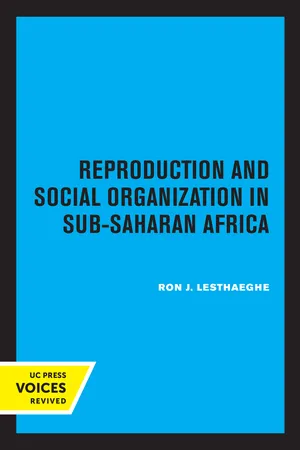
Reproduction and Social Organization in Sub-Saharan Africa
Ron J. Lesthaeghe
- 570 Seiten
- English
- ePUB (handyfreundlich)
- Nur im Web verfügbar
Reproduction and Social Organization in Sub-Saharan Africa
Ron J. Lesthaeghe
Über dieses Buch
Unlike most Asian and Latin American countries, sub-Saharan Africa has seen both an increase in population growth rates and a weakening of traditional patterns of child-spacing since the 1960s. It is tempting to conclude that sub-Saharan countries have simply not reached adequate levels of income, education, and urbanization for a fertility decline to occur. This book argues, however, that such a socioeconomic threshold hypothesis will not provide an adequate basis for comparison. These authors take the view that any reproductive regime is also anchored to a broader pattern of social organization, including the prevailing modes of production, rules of exchange, patterns of religious systems, kinship structure, division of labor, and gender roles. They link the characteristic features of the African reproductive regime with regard to nuptiality, polygyny, breastfeeding, postpartum abstinence, sterility, and child-fostering to other specifically African characteristics of social organization and culture. Substantial attention is paid to the heterogeneity that prevails among sub-Saharan societies and considerable use is made, therefore, of interethnic comparisons. As a result the book goes considerably beyond mere demographic description and builds bridges between demography and anthropology or sociology. This title is part of UC Press's Voices Revived program, which commemorates University of California Press's mission to seek out and cultivate the brightest minds and give them voice, reach, and impact. Drawing on a backlist dating to 1893, Voices Revived makes high-quality, peer-reviewed scholarship accessible once again using print-on-demand technology. This title was originally published in 1989.
Häufig gestellte Fragen
Information
Inhaltsverzeichnis
- Cover
- Title
- Copyright
- Contents 1
- Contributors
- Acknowledgments
- Introduction Ron Lesthaeghe
- CHAPTER ONE Production and Reproduction in Sub-Saharan Africa: An Overview of Organizing Principles Ron Lesthaeghe INTRODUCTION
- GENERAL CONNECTIONS BETWEEN SOCIAL ORGANIZATION AND REPRODUCTIVE REGIMES OF SUB-SAHARAN AFRICA
- CAVEATS, VARIATIONS, AND ADDITIONAL DIMENSIONS
- CONCLUSIONS
- CHAPTER TWO The Components of Sub-Saharan Reproductive Regimes and Their Social and Cultural Determinants Empirical Evidence Ron Lesthaeghe Frank Eelens INTRODUCTION
- THE DEPENDENT VARIABLES
- SOCIAL AND CULTURAL INDICATORS
- THE LINKS
- FURTHER PROBES INTO THE EFFECTS OF ORGANIZATIONAL PATTERNS AND SOCIOECONOMICS DIFFERENTIATION
- CONCLUSIONS
- CHAPTER THREE Regional Variation in Components of Child-Spacing: The Role of Women’s Education Ron Lesthaeghe Camille Vanderhoeft Samuel Gaisie Ghislaine Delaine INTRODUCTION
- MEASUREMENT OF DEPENDENT VARIABLES BY REGION AND SUBGROUP
- THE COMPONENTS OF THE OVERALL POSTPARTUM NONSUSCEPTIBLE PERIOD (NSP)
- EFFECTS OF SOCIOECONOMIC AND CULTURAL VARIABLES ON REGIONAL PATTERNS OF CHILD-SPACING FOR DIFFERENT AGE AND EDUCATION SUBGROUPS
- ARE EDUCATIONAL EFFECTS WITHIN REGIONS RELATED TO CONTEXTUAL VARIABLES?
- POSTPARTUM NONSUSCEPTIBILITY AND CONTRACEPTION: THE BALANCE
- CONCLUSIONS
- CHAPTER FOUR A Comparative Study of the Levels and the Differentials of Sterility in Cameroon, Kenya, and Sudan Ulla Larsen
- SUBFERTILITY IN SUB-SAHARAN AFRICA
- MODELS OF STERILITY
- THE COVARIATES OF STERILITY
- THE LEVELS OF STERILITY IN CAMEROON, KENYA, AND SUDAN
- CONCLUSIONS
- CHAPTER FIVE The Demography of Polygyny in Sub-Saharan Africa Noreen Goldman Anne Pebley INTRODUCTION
- METHODS
- RESULT
- CONCLUSIONS
- CHAPTER SIX The Nuptiality Regimes in Sub-Saharan Africa Ron Lesthaeghe Georgia Kaufmann Dominique Meekers THE ISSUES
- MEASUREMENT PROBLEMS AND THE DEFINITION OF INDICATORS
- ADDITIONAL NOTES ON THE FORMAL DEMOGRAPHY OF POLYGYNY
- REGIONAL PATTERNS OF NUPTIALITY AND POLYGYNY
- THE CONSTRUCTION OF AN ETHNIC NUPTIALITY AND SOCIAL STRUCTURE FILE
- MAJOR ANTHROPOLOGICAL THEORIES AND THEIR EMPIRICAL TESTING
- TRENDS IN POLYGYNY AND AGE AT MARRIAGE
- PREMARITAL FERTILITY
- CONCLUSIONS
- CHAPTER SEVEN Polygyny and Fertility in Sub-Saharan Africa Anne R. Pebley Wariara Mbugua INTRODUCTION
- DATA AND METHODS
- POLYGYNY AND FERTILITY
- MULTIVARIATE RESULTS
- INTERMEDIATE VARIABLES: KENYA
- INTERMEDIATE VARIABLES: IVORY COAST
- DISCUSSION
- SOCIETAL EFFECTS
- CHAPTER EIGHT Labor Circulation, Marriage, and Fertility in Southern Africa Ian Timaeus Wendy Graham INTRODUCTION
- THE MIGRANT LABOR SYSTEM
- THE MARRIAGE SYSTEMS OF BOTSWANA AND LESOTHO
- MARITAL STATUS AND FERTILITY
- FEMALE MIGRATION AND FERTILITY
- MALE MIGRATION AND MARITAL FERTILITY
- MODERN METHODS OF FERTILITY CONTROL
- THE OVERALL LEVEL OF FERTILITY
- CHAPTER NINE Childrearing versus Childbearing: Coresidence of Mother and Child in Sub-Saharan Africa Hilary J. Page INTRODUCTION
- PATTERNS OF PARENTING
- Conclusions
- DATA
- FIRST RESULTS: THE PREVALENCE OF NONMATERNAL RESIDENCE
- SOCIAL ORGANIZATION AND THE PREVALENCE OF NONMATERNAL RESIDENCE
- CONCLUSIONS
- CHAPTER TEN Strategies of Child-Fosterage among Mende Grannies in Sierra Leone Caroline Bledsoe Uche Isiugo-Abanihe INTRODUCTION
- THE STUDY
- MENDE FOSTERAGE
- WHICH PEOPLE SEND CHILDREN TO GRANNIES?
- ADVANTAGES AND DISADVANTAGES TO CHILDREN IN BEING RAISED BY GRANNIES
- BENEFITS TO GRANNIES IN MINDING CHILDREN
- MINDING CHILDREN IN ORDER TO ACQUIRE RESOURCES FROM THE MODERN WORLD
- THE SOCIAL AND REGIONAL SIGNIFICANCE OF GRANNIES FOSTERING YOUNG CHILDREN FOR SUPPORTING FERTILITY
- CHAPTER ELEVEN Social Organization, Economic Crises, and the Future of Fertility Control in Africa Ron Lesthaeghe INTRODUCTION
- THE CRISIS-LED TRANSITION
- THE COMMUNITY PERSPECTIVE
- IS THE ASIAN FAMILY PLANNING EXPERIENCE RELEVANT FOR SUB-SAHARAN AFRICA?
- THE GRASS-ROOTS: WHO ARE THEY?
- CONCLUSIONS
- AppendixesAPPENDIX A Indicators of Social, Cultural, and Reproductive Regimes; 61 Ethnic Groups, WFS Surveys
- Indexes Subject Index
- Author Index
- Ethnic Group Index
- Geographical Index